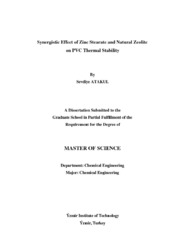Please use this identifier to cite or link to this item:
https://hdl.handle.net/11147/3743Full metadata record
| DC Field | Value | Language |
|---|---|---|
| dc.contributor.advisor | Balköse, Devrim | en |
| dc.contributor.author | Atakul, Sevdiye | - |
| dc.date.accessioned | 2014-07-22T13:52:16Z | - |
| dc.date.available | 2014-07-22T13:52:16Z | - |
| dc.date.issued | 2004 | en |
| dc.identifier.uri | http://hdl.handle.net/11147/3743 | - |
| dc.description | Thesis (Master)--Izmir Institute of Technology, Chemical Engineering, Izmir, 2004 | en |
| dc.description | Includes bibliographical references (leaves: 115-118) | en |
| dc.description | Text in English; Abstract: Turkish and English | en |
| dc.description | xv, 118 leaves | en |
| dc.description.abstract | At high temperatures (about 100 °C), PVC decomposes by the removal of hydrogen chloride (HCl) gas and the decomposition is accompanied by polymer discoloration going from yellow to orange, brown and black. In order to prevent decomposition of PVC, thermal stabilizers are added to PVC. The synergistic effect of zinc stearate (ZnSt2) and/or natural zeolite (clinoptilolite) on PVC thermal stability was investigated in this project. For this purpose PVC plastisol was prepared by mixing poly(vinyl chloride) (PVC) and dioctyphthalate (DOP) and stabilized with different amounts of metal soaps and zeolite.The materials and the prepared PVC plastisols were characterized by spectroscopic and thermal analysis techniques. The gelation of the plastisols was observed by optical microscopy and the photographs were taken by a digital camera. The complete gelation was observed at 185 °C. The morphology of PVC plastigel films were studied by scanning electron microscope (SEM). SEM with energy dispersive X-ray (EDX) analysis was used to obtain elemental compositions in polymer and particle phases. The thermal stability of PVC plastigels in terms of color were obtained by heating them in a static vaccum oven. When zeolite was used as a primary stabilizer it prevented the early blackening of the film. Kinetic study of dehydrochlorination was determined by 763 PVC Thermomat equipment for unstabilized and stabilized PVC plastigels. When PVC plastigels were heated in PVC Thermomat in the presence of nitrogen gas, the conductivity of water which nitrogen gas was passed due to the evolved HCl, changed with respect to time. The period when conductivity starts to increase is called as induction time, and the period when the conductivity value reaches to 50 uS/cm is called as stability time. The induction and stability time values of unstabilized and stabilized PVC plastigel films were obtained at 140 and 160 °C. The stabilizing effect of zeolite on the increase in the induction period of the sample was considered the result from the absorption of HCl which was thought to reduce the autocatalytic effect of HCl evolved at the initial stages of dehydrochlorination. Since the induction time of the sample having 0.53% ZnSt2 and 0.53% zeolite was higher than the PVC plastigels having only ZnSt2 or zeolite the synergistic effect on thermal stability was observed at low levels of them. | en |
| dc.language.iso | en | en_US |
| dc.publisher | Izmir Institute of Technology | en |
| dc.rights | info:eu-repo/semantics/openAccess | en_US |
| dc.subject.lcc | TP1180.V48 A83 2004 | en |
| dc.subject.lcsh | Polyvinyl chloride--Additives | en |
| dc.subject.lcsh | Polyvinyl chloride--Deterioration | en |
| dc.subject.lcsh | Zinc | en |
| dc.subject.lcsh | Zeolites | en |
| dc.title | Synergistic effect of zinc stearate and natural zeolite on PVC thermal stability | en_US |
| dc.type | Master Thesis | en_US |
| dc.institutionauthor | Atakul, Sevdiye | - |
| dc.department | Thesis (Master)--İzmir Institute of Technology, Chemical Engineering | en_US |
| dc.relation.publicationcategory | Tez | en_US |
| item.fulltext | With Fulltext | - |
| item.grantfulltext | open | - |
| item.languageiso639-1 | en | - |
| item.openairecristype | http://purl.org/coar/resource_type/c_18cf | - |
| item.cerifentitytype | Publications | - |
| item.openairetype | Master Thesis | - |
| Appears in Collections: | Master Degree / Yüksek Lisans Tezleri | |
Files in This Item:
| File | Description | Size | Format | |
|---|---|---|---|---|
| T000287.pdf | MasterThesis | 2.54 MB | Adobe PDF |  View/Open |
CORE Recommender
Page view(s)
556
checked on Nov 18, 2024
Download(s)
100
checked on Nov 18, 2024
Google ScholarTM
Check
Items in GCRIS Repository are protected by copyright, with all rights reserved, unless otherwise indicated.